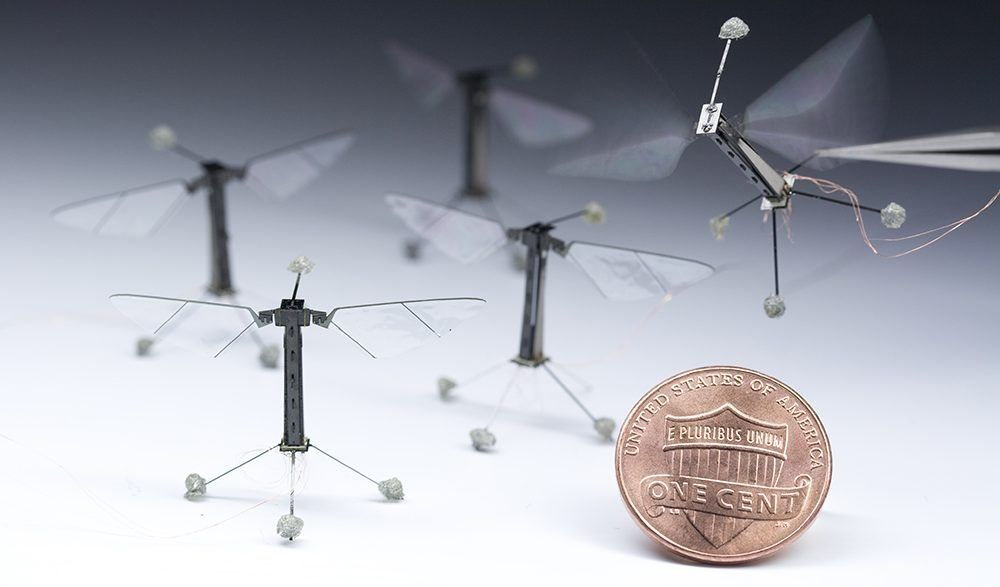Page 10820
Oct 6, 2016
Project Originally Funded By DARPA Seeks To Replace Bees With Tiny, Winged Robots
Posted by Karen Hurst in categories: drones, food, information science, internet, military, mobile phones, robotics/AI, transhumanism
Got a bee shortage? No problem, DARPA has you covered.
Following the news that the honeybee is now officially an endangered species as “colony collapse disorder” accelerates, it seems that a Harvard research team has the solution – robotic honeybees. Instead of attempting to save the bees by reducing the use of pesticides or revising safety standards for cell phone radiation, the focus has shifted to replacing the bees altogether. Harvard University researchers, led by engineering professor Robert Wood have been tweaking “RoboBees” since their initial introduction in 2009. The bee-sized robots made of titanium and plastic represent a breakthrough in the field of micro-aerial vehicles. The size of the components needed to create flying robots were previously too heavy to make a such a small structure lightweight enough to achieve flight. Current models weigh only 80 mg and have been fitted with sensors that detect light and wind velocity.
Researchers claim that the bees could artificially pollinate entire fields of crops and will soon be able to be programmed to live in an artificial hive, coordinate algorithms and communicate among themselves about methods of pollination and the locations of particular crops. In addition, RoboBees have been suggested for other uses including searching disaster sites for survivors, monitoring traffic, and “military and police applications.” These applications could include using RoboBees to “scout for insurgents” on battlefields abroad or allowing police and SWAT teams to use the micro-robots to gather footage inside buildings.
Oct 6, 2016
Why US and NATO Military are looking at Blockchain
Posted by Karen Hurst in categories: bitcoin, military
Oct 6, 2016
Brain Cells That Cool the Body
Posted by Karen Hurst in categories: biotech/medical, neuroscience
Summary: Researchers have identified a set of heat sensing neurons that prompt both nervous system and behavioral changes that help cool the body.
Source: NIH.
The body’s temperature is closely regulated. We sense temperature changes in the environment through specialized nerve cells in the outer layers of the skin. If we are too hot or too cold, our nervous system activates responses to help change our temperature. We can sweat to cool down or shiver to generate heat. Our blood vessels can constrict to conserve heat or expand to release heat. To avoid discomfort, we sometimes seek out different environments―choosing to go into an air conditioned room or sit by a heater.
Oct 6, 2016
Time #24: Has Physics Finally Caught up With Nature?
Posted by Karen Hurst in category: physics
Oct 6, 2016
UFO sighting: Flying saucer over China stops traffic
Posted by Karen Hurst in category: transportation
# UFO # China – UFO sighting: Flying saucer over China stops traffic : Commuters in a busy street of Guangzhou, China, were brought to a halt when they spotted a flying saucer hovering over the traffic.
The dashboard camera of one car snapped the flying saucer. The car pulled up behind crowds that were staring at the strange phenomenon. The footage that was taken from the car shows the driver coming to a stop, while people on the road were looking up with wide-open eyes and mouths.
Continue reading “UFO sighting: Flying saucer over China stops traffic” »
Oct 6, 2016
China Wants to Build a 20-Seat, Reusable Space Plane for Rich Tourists
Posted by Karen Hurst in category: space travel
Oct 6, 2016
Field of quantum computing is undergoing a rapid shake-up
Posted by Karen Hurst in categories: computing, quantum physics
Oct 6, 2016
A quantum beamsplitter that relies on dust
Posted by Karen Hurst in category: quantum physics
Scientific Method —
A quantum beamsplitter that relies on dust.
Researchers divide photons when they should group together.
Continue reading “A quantum beamsplitter that relies on dust” »

















